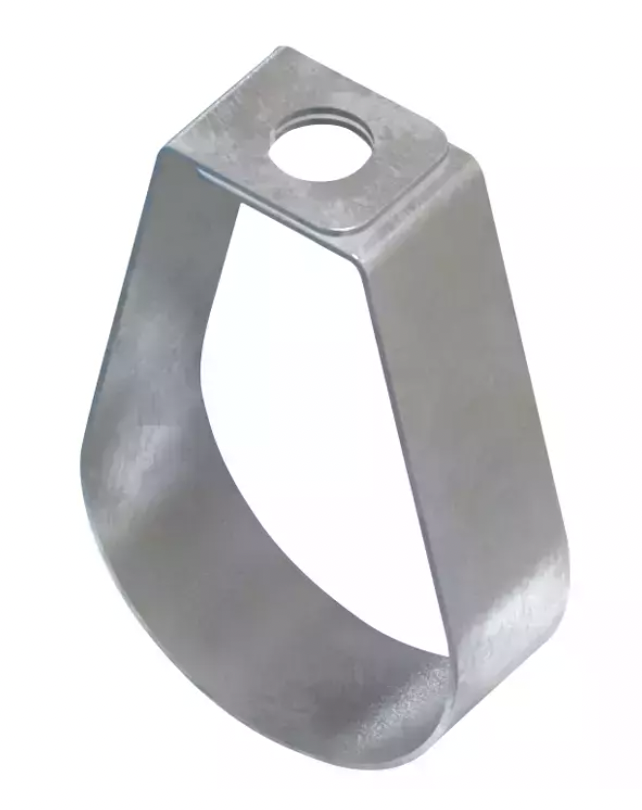Ultimate Guide to U Clamps, Chilly Clamps, and Hanger Clamps: Secure Your Pipes Effectively
Pipe clamps are versatile and essential tools used to secure, support, and hold pipes in various industries and applications. These clamps come in a range of sizes, materials, and designs to accommodate different pipe types and environmental conditions. They play a crucial role in ensuring that pipes remain stable, well-aligned, and protected from potential damage due to vibrations or external forces.
The primary purpose of pipe clamps is to provide support and distribute the weight of the piping system evenly. They help maintain the integrity of the pipes and prevent damage from potential hazards like corrosion, abrasion, and thermal expansion. Pipe clamps also serve to absorb shock and dampen vibrations, ensuring a smooth and efficient flow of fluids within the system.
Pipe clamps are available in various materials, including plastic, steel, and stainless steel, each offering specific advantages depending on the application. For example, stainless steel clamps are often used in corrosive environments or where a high level of durability and strength is required. On the other hand, plastic clamps are lightweight, resistant to chemical corrosion, and ideal for use in non-critical applications.
The design of pipe clamps varies based on their intended use and the requirements of the specific project. Some common types of pipe clamps include U-bolt clamps, strut clamps, riser clamps, and split band clamps. Each of these designs offers unique benefits and is suitable for specific applications and environments.
Pipe clamps are essential components in a variety of industries, including construction, oil and gas, chemical processing, and wastewater management. They provide stability, support, and protection for pipes, ensuring the smooth and efficient operation of any piping system.
-
Pipe clamps offer numerous advantages in various applications and industries, making them an essential component in many piping systems. Some of the key benefits of using pipe clamps include:
Stability and Support: Pipe clamps provide support to the piping system, ensuring that pipes remain stable and well-aligned. This helps to prevent sagging, bending, or misalignment, which can lead to leaks or damage to the pipes.
Load Distribution: Clamps distribute the weight of the piping system evenly across the supporting structure, reducing stress on the pipes and the overall system.
Vibration and Shock Absorption: Pipe clamps can dampen vibrations and absorb shocks, preventing damage and reducing noise in the system. This is particularly important in applications where equipment is prone to vibrations or pipes are subject to sudden pressure changes.
Protection: Clamps can help protect pipes from external factors, such as corrosion, abrasion, or thermal expansion. By using appropriate clamps made from corrosion-resistant materials or with protective coatings, the lifespan of the pipes can be extended.
Easy Installation and Adjustment: Many pipe clamps are designed for quick and easy installation and adjustment, allowing for efficient and hassle-free installation or modifications to the piping system.
Versatility: Pipe clamps come in various sizes, materials, and designs, making them suitable for a wide range of applications and pipe types. This versatility allows engineers and contractors to select the appropriate clamp for their specific project requirements.
Cost-Effective: Pipe clamps are generally a cost-effective solution for securing and supporting pipes, as they help to prevent damage, leaks, and other issues that can result in costly repairs or replacements.
Improved Safety: By providing proper support and stability to the piping system, pipe clamps can help to reduce the risk of accidents caused by pipe failures, leaks, or other issues.
-
Pipe clamps are used in a wide range of industries and applications due to their versatility and ability to secure and support pipes. Some of the most common areas where pipe clamps are used include:
Construction: In residential, commercial, and industrial construction projects, pipe clamps help secure plumbing, electrical conduits, and HVAC systems, ensuring stability and preventing damage.
Oil and Gas Industry: Pipe clamps are used extensively in the oil and gas sector to support pipelines and process equipment, ensuring the safe and efficient transport of fluids and gases.
Chemical Processing: In chemical processing plants, pipe clamps help manage pipelines carrying corrosive and hazardous chemicals, ensuring safety and reducing the risk of leaks.
Water and Wastewater Management: Pipe clamps are used in water treatment plants, sewage systems, and stormwater management to support and stabilize the pipes, preventing damage due to ground movement or vibrations.
Manufacturing and Industrial Applications: Pipe clamps are used in various manufacturing and industrial settings, such as food and beverage processing, pharmaceuticals, and pulp and paper production, to support and stabilize pipelines.
Fire Protection Systems: Pipe clamps are used to secure fire sprinkler pipes, ensuring that they remain in place and function correctly in the event of a fire.
CHILLY CLAMPS or HANGER CLAMPS
Hangar pipe clamps or popularly known as Chilly Clamps in India, are a specialized type of pipe clamp designed to suspend and support pipes in various industries and applications. These clamps ensure that the piping system remains stable, secure, and well-aligned, particularly when the pipes need to be suspended from a ceiling, wall, or other structural elements. Hangar pipe clamps play a crucial role in maintaining the integrity of the pipes and preventing damage due to vibrations, external forces, or thermal expansion.
Available in a variety of materials, sizes, and designs, hangar pipe clamps cater to the specific requirements of different piping systems. Common materials include steel, stainless steel, and plastic, each offering distinct benefits depending on the application. For instance, stainless steel clamps provide high strength and corrosion resistance, making them suitable for harsh environments or where durability is a priority. Plastic clamps, on the other hand, are lightweight and resistant to chemical corrosion, making them ideal for use in non-critical applications.
PRICE LIST FOR CHILLY CLAMPS or HANGER CLAMPS
(All Rates are in INR- Price mentioned are per Piece)
| SIZE | PRICE |
|---|---|
| 25mm | 9.00 |
| 32mm | 11.00 |
| 40mm | 13.00 |
| 50mm | 16.00 |
| 65mm | 19.00 |
| 80mm | 25.00 |
| 100mm | 27.00 |
| 125mm | 39.00 |
| 150mm | 45.00 |
| 200mm | 75.00 |
| 250mm | 120.00 |
Terms & Conditions
Rates are EX Delhi Warehouse; Cartage & Freight shall be as per actual
GST @ 18% shall be extra
U CLAMP OR U BOLTS WITH NUT & WASHER
The Versatility of U-Bolts: Understanding the Use of U-Bolts with Nuts and Washers
Introduction
U-bolts, named for their distinctive U-shape, are versatile fasteners used in various industries and applications. These heavy-duty bolts are typically used to secure pipes, tubes, and other cylindrical objects to surfaces or structures. Combined with nuts and washers, U-bolts provide a secure and stable connection that can withstand substantial forces. This article will discuss the design, applications, and benefits of using U-bolts with nuts and washers.
Design and Components
U-bolts consist of three main components: the curved bolt, nuts, and washers. The U-shaped bolt is typically made of steel or stainless steel, with threaded ends that extend beyond the curve. The nuts and washers are used to secure the bolt in place and distribute the load evenly.
U-Bolt: The U-bolt's shape and dimensions depend on the specific application. The curve's diameter and the length of the threaded ends vary according to the size of the object being secured and the surface it is being attached to.
Nuts: Nuts are used to fasten the U-bolt, ensuring a secure connection. The number of nuts depends on the design; typically, two nuts are used per threaded end.
Washers: Washers are placed between the nuts and the surface being clamped to distribute the load evenly, prevent damage to the surface, and provide a more secure connection.
Benefits of Using U-Bolts with Nuts and Washers
The combination of U-bolts, nuts, and washers provides several benefits:
Secure and stable connection: The U-shape and threaded ends of the U-bolt, combined with the nuts and washers, create a strong and secure connection that can withstand significant forces and vibrations.
Easy installation and adjustment: U-bolts are easy to install and can be adjusted by tightening or loosening the nuts, making them suitable for various applications and allowing for easy maintenance or modifications.
Even load distribution: The washers help distribute the load evenly, reducing the risk of damage to the surface and ensuring a stable connection.
Corrosion resistance: Stainless steel U-bolts, nuts, and washers offer excellent corrosion resistance, making them suitable for use in harsh environments, such as marine and industrial settings.
U-bolts with nuts and washers are a versatile and reliable solution for securing various cylindrical objects to surfaces or structures. Their simple design, ease of installation, and adaptability make them a popular choice for a wide range of applications across various industries. By understanding the components and benefits of U-bolts, users can select the appropriate U-bolt configuration for their specific needs, ensuring a secure and durable connection.
PRICE LIST FOR U CLAMPS OR U BOLTS WITH NUT & WASHER
(All Rates are in INR- Price mentioned are per Piece)
| SIZE | PRICE |
|---|---|
| 15mm | 7.50 |
| 20mm | 8.00 |
| 25mm | 10.00 |
| 32mm | 11.00 |
| 40mm | 12.00 |
| 50mm | 15.00 |
| 65mm | 17.00 |
| 80mm | 21.00 |
| 100mm | 24.00 |
| 125mm | 30.00 |
| 150mm | 36.00 |
| 200mm | 48.00 |
| 250mm | 78.00 |
| 300mm | 87.00 |
| 350mm | 156.00 |
| 400mm | 182.00 |
Terms & Conditions
Rates are EX Delhi Warehouse; Cartage & Freight shall be as per actual
GST @ 18% shall be extra



